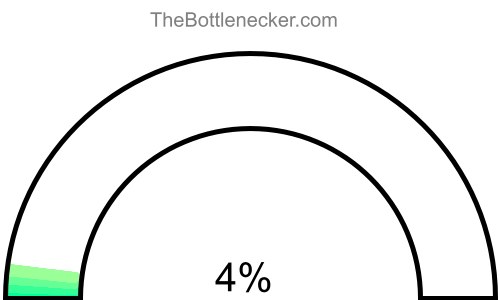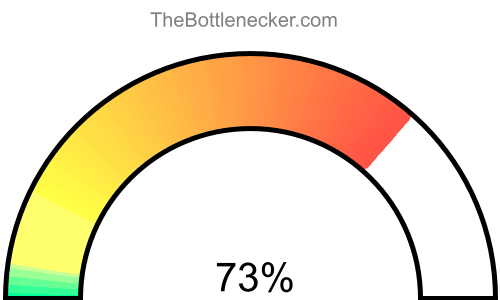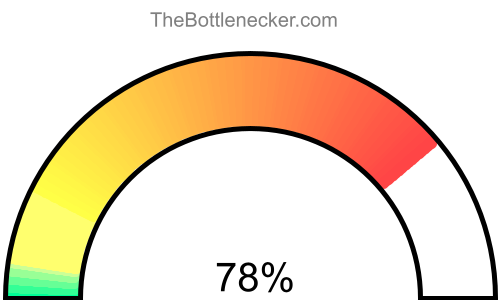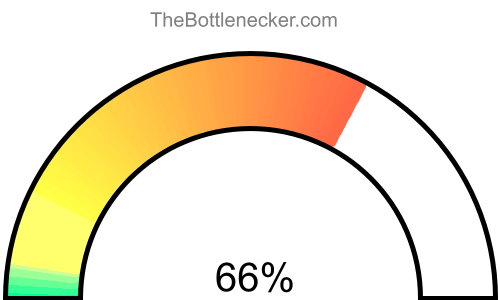StarCraft II: Wings of Liberty bottleneck calculator
Intel Core2 Duo E8135 and AMD Radeon RX 7900 XTX
StarCraft II: Wings of Liberty
6400 × 4800
1 monitor
1. Select game
Currently selected:

StarCraft II: Wings of Liberty
2. Select processor
Currently selected:
Intel Core2 Duo E8135
3. Select graphic card
Currently selected:
AMD Radeon RX 7900 XTX
4. Select resolution
Currently selected:
6400 × 4800 resolution
(1 monitor)
Calculation result
Bottleneck percentage
The Intel Core2 Duo E8135 may serve as a bottleneck for the AMD Radeon RX 7900 XTX in the StarCraft II: Wings of Liberty with 6400 × 4800 and 1 monitor. Although the AMD Radeon RX 7900 XTX is engineered to manage heavy graphical tasks, the Intel Core2 Duo E8135 might lack the processing power needed to fully unlock the AMD Radeon RX 7900 XTX capabilities. This imbalance may inhibit the overall efficiency of your system, slowing down processing and possibly compromising graphical fidelity. For a more harmonious hardware setup, upgrading to a high-performing processor that can meet the demands of current software and games is advised.

In a configuration featuring the Intel Core2 Duo E8135 and AMD Radeon RX 7900 XTX, with a screen resolution of 6400 × 4800 and 1 monitor, the system experiences a 3.5% bottleneck for StarCraft II: Wings of Liberty.
Processor and graphic card utilizations
In a computing setup featuring the Intel Core2 Duo E8135 and AMD Radeon RX 7900 XTX, under the context of StarCraft II: Wings of Liberty with a screen resolution of 6400 × 4800 and 1 monitor, the processor is expected to have an utilization rate of 83.3%, while the graphics card is projected to be utilized at 72.7%.
It's crucial to understand that these figures signify theoretical maximums based on typical CPU-to-GPU workload distribution ratios for certain tasks or gaming experiences. Achieving these high levels of utilization in real-world settings can be a challenging endeavor.

Playability
- Playable
- Frames per second
-
A game is considered "playable" if it can consistently run at 60 FPS on high settings. This ensures a smooth and visually appealing gaming experience free from lags or stutters.
Heatmap of bottleneck
In gaming scenarios, your AMD Radeon RX 7900 XTX might not attain its full performance potential due to a lack of optimal utilization. This happens when the Intel Core2 Duo E8135 fails to handle and transmit data to the AMD Radeon RX 7900 XTX at an adequate speed. As a result, the Intel Core2 Duo E8135 will be operating at its maximum capacity, while the AMD Radeon RX 7900 XTX remains underutilized.
When it comes to bottlenecks, a processor bottleneck is generally viewed as more detrimental than a graphics card bottleneck. In cases of a processor bottleneck, the Intel Core2 Duo E8135 capacity reaches its limits, which may adversely affect other applications running concurrently. This situation can result in diminished responsiveness and multi-tasking capabilities.
Moreover, due to the processor bottleneck, the system might not leverage the full performance capabilities of the AMD Radeon RX 7900 XTX. Consequently, there could be restrictions in graphical rendering, frame rates, and the overall gaming experience.
To visualize these bottlenecks, consider examining our heatmap. On this heatmap, the X-axis represents the CPU Score, while the Y-axis denotes the GPU Score. A quick glance at this heatmap can offer invaluable insights into potential bottlenecks within various system configurations.

By correlating your Intel Core2 Duo E8135 CPU Score and AMD Radeon RX 7900 XTX GPU Score on the heatmap, you can acquire a more comprehensive understanding of how these components interact and where the bottlenecks might occur. Making well-informed hardware choices based on this heatmap analysis can lead to a more balanced and efficient computing setup for your specific needs.
General bottleneck calculations
The bottleneck calculations presented here are geared specifically towards in-game scenarios, providing valuable insights into how your hardware configuration could impact gaming performance. However, it's crucial to understand that bottlenecks can manifest in various types of tasks and applications. Below, you will find bottleneck calculations segmented into three primary categories: General Tasks, CPU Intensive Tasks, and GPU Intensive Tasks. This segmentation allows for a more nuanced understanding of how your system's components interact under different types of workloads.
General tasks bottleneck result
For general tasks that include web browsing, video streaming, office applications, and basic multitasking, the bottleneck result offers a comprehensive look at how well your CPU and GPU are balanced. If the bottleneck percentage leans heavily towards either the CPU or GPU, it might be beneficial to consider an upgrade for the more taxed component to ensure smoother system performance.
CPU intensive tasks bottleneck result
When it comes to CPU intensive tasks, such as video editing, 3D rendering, or scientific computing, the bottleneck calculation primarily focuses on whether your processor is powerful enough to handle these workloads efficiently. Here, a high bottleneck percentage for the CPU would indicate that your processor is the limiting factor, making tasks slower than they could be with a more robust CPU.
GPU intensive tasks bottleneck result
In scenarios involving GPU intensive tasks—like advanced gaming, graphical rendering, or video processing—the bottleneck calculation highlights the efficiency of your graphics card in relation to the overall system. A high bottleneck percentage on the GPU side would suggest that your graphics card is the limiting component, potentially hindering your system's ability to deliver optimal graphical performance.
Bottleneck solutions
Replace processor
When the processor becomes the system's bottleneck, upgrading it is often the most straightforward way to improve performance. Opting for a faster processor with more cores and higher clock speeds can effectively minimize or even eliminate the bottleneck, making it easier for your graphics card to perform to its maximum capability.
- Intel Core i5-7500 Full details
- Intel Core i3-8100 Full details
- Intel Core i5-6600 Full details
- AMD FX-8350 Full details
- Intel Core i5-7600T Full details
- Intel Core i7-4770T Full details
- AMD Ryzen 3 2200GE Full details
- Intel Core i5-6500 Full details
- Intel Core i5-4590 Full details
- Intel Core i5-7400 Full details
- Intel Core i7-2600 Full details
- Intel Core i5-4690 Full details
- AMD FX-8370E Full details
- AMD FX-8300 Full details
- Intel Core i5-6402P Full details
- Intel Core i7-4700EQ Full details
- Intel Core i7-3770T Full details
- Intel Core i3-9100T Full details
- AMD FX-8320 Full details
- Intel Core i7-2600K Full details
- Intel Core i5-4670 Full details
- Intel Core i7-4785T Full details
- Intel Core i5-4690S Full details
- Intel Core i5-5675R Full details
- Intel Core i5-4670K Full details
- Intel Core i5-5675C Full details
- Intel Core i5-6600T Full details
- Intel Core i5-4690K Full details
- Intel Xeon E3-1220 v5 Full details
- Intel Xeon E5-1620 Full details
- Intel Xeon E3-1225 v5 Full details
- Intel Xeon X5660 Full details
- Intel Xeon X5670 Full details
- Intel Xeon E5-2440 Full details
- Intel Xeon E5-2620 Full details
- Intel Xeon E3-1225 v3 Full details
- Intel Xeon E5-2630L Full details
- Intel Xeon X5687 Full details
- Intel Xeon E3-1245 Full details
- Intel Xeon E3-1270 Full details
- Intel Xeon E3-1240 Full details
- Intel Xeon E5-2643 Full details
- Intel Xeon E5-2609 v4 Full details
- Intel Xeon E3-1275 Full details
- Intel Xeon E3-1226 v3 Full details
- Intel Xeon E5-2430 Full details
- Intel Xeon E3-1280 Full details
- Intel Xeon W-2104 Full details
- Intel Xeon E3-1240L v3 Full details
- Intel Xeon E3-1225 v6 Full details

Impact of Changing Screen Resolution
Interestingly, if you're facing a processor bottleneck, altering the screen resolution may have a counterintuitive impact. Elevating the screen resolution will primarily stress the graphics card, thereby reducing the proportion of work that the processor needs to do in certain tasks. This makes it less likely that the processor will max out, though it does not replace the benefits of a processor upgrade for a balanced system.
Read moreReplace graphic cards
If the processor is causing the bottleneck, replacing the graphic card isn't generally recommended unless you're also planning to upgrade the processor. Downgrading your graphics card to better match the processor might alleviate the bottleneck, but it often results in a decrease in overall system performance, especially in graphics-heavy tasks like gaming or 3D rendering.
- NVIDIA GeForce RTX 4080 Full details
- NVIDIA GeForce RTX 4080 SUPER Full details
- NVIDIA GeForce RTX 4070 Ti SUPER Full details
- NVIDIA GeForce RTX 4070 Ti Full details
- NVIDIA GeForce RTX 4070 SUPER Full details
- NVIDIA GeForce RTX 3090 Ti Full details
- AMD Radeon RX 7900 XT Full details
- AMD Radeon RX 6950 XT Full details
- NVIDIA RTX 6000 Ada Generation Full details
- NVIDIA GeForce RTX 4070 Full details
- AMD Radeon RX 7900 GRE Full details
- NVIDIA GeForce RTX 3080 Ti Full details
- NVIDIA GeForce RTX 3090 Full details
- AMD Radeon RX 6900 XT Full details
- NVIDIA GeForce RTX 3080 Full details
- NVIDIA RTX 4000 Ada Generation Full details
- AMD Radeon RX 6800 XT Full details
- NVIDIA RTX 5000 Ada Generation Full details
- AMD Radeon RX 7800 XT Full details
- NVIDIA GeForce RTX 3070 Ti Full details
- NVIDIA GeForce RTX 4060 Ti Full details
- NVIDIA GeForce RTX 3070 Full details
- AMD Radeon RX 7700 XT Full details
- AMD Radeon RX 6800 Full details
- NVIDIA GeForce RTX 2080 Ti Full details
- NVIDIA RTX 4000 SFF Ada Generation Full details
- NVIDIA RTX A4500 Full details
- NVIDIA RTX A5500 Full details
- AMD Radeon RX 6750 XT Full details
- NVIDIA GeForce RTX 3060 Ti Full details
- NVIDIA GeForce RTX 4060 Full details
- AMD Radeon RX 6700 XT Full details
- NVIDIA GeForce RTX 2080 SUPER Full details
- NVIDIA TITAN V Full details
- AMD Radeon RX 6700 Full details
- NVIDIA TITAN Xp COLLECTORS EDITION Full details
- NVIDIA GeForce GTX 1080 Ti Full details
- NVIDIA GeForce RTX 2080 Full details
- NVIDIA TITAN Xp Full details
- AMD Radeon PRO W7800 Full details
- AMD Radeon PRO W7900 Full details
- NVIDIA RTX A6000 Full details
- NVIDIA RTX A5000 Full details
- AMD Radeon PRO W7700 Full details
- NVIDIA TITAN RTX Full details
- NVIDIA Quadro GV100 Full details
- AMD Radeon PRO W6800 Full details
- NVIDIA Quadro RTX 8000 Full details
- NVIDIA RTX A4000 Full details
- NVIDIA Quadro RTX 6000 Full details

Impact of Changing Screen Resolution
Increasing the screen resolution in this case will demand more from your graphics card and can make the processor's bottleneck less noticeable in some scenarios, but again, it won't entirely solve the underlying problem.
Read moreOffers for AMD Radeon RX 7900 XTX
 RX7900XTX 24G
RX7900XTX 24G
 rx7900xtx-24g
rx7900xtx-24g
 GAMING OC
GAMING OC
 Hellhound Spectral
Hellhound Spectral
 Phantom Gaming OC
Phantom Gaming OC
 TUF GAMING OC
TUF GAMING OC
| Product name | Merchant | Available | Price |
Merchant
Available
Price
|
|---|---|---|---|---|

|
Yes | 189.99 $ |
Yes
|
|
|
GIGABYTE B650 AORUS Elite AX AMD B650 ATX Motherboard with DDR5, PCIe 5.0, WiFi 6E, 5-Year Warranty 23 new from 199.00 $. 33 used from 120.00 $. Last updated 31 minutes ago. |

|
Yes | 199.99 $ |
Yes
|
|
PowerColor Hellhound AMD Radeon RX 7900 XTX Graphics Card 4 new from 849.00 $. 9 used from 797.00 $. Last updated 51 minutes ago. |

|
Yes | 849.99 $ |
Yes
|
|
5 new from 899.00 $. 5 used from 822.00 $. Last updated 28 minutes ago. |

|
Yes | 899.00 $ |
Yes
|

|
Yes | 929.99 $ |
Yes
|
Product pricing and availability information was updated as of the date and time listed, but is subject to change. If you choose to purchase a product from a retailer, the price and availability displayed on their website at the time of purchase will apply. We may earn a commission from qualifying purchases made through the links to participating retailers on this site. However, this does not impact the products or prices that are displayed or the order in which prices are listed.
Bottleneck calculator types
Select purpose bottleneck calculator
Before selecting a bottleneck calculator, consider your primary computing tasks. For general activities like web browsing and office work, the calculator evaluates the balance between your CPU and GPU. If you focus on CPU-intensive tasks like video editing or 3D rendering, the tool will highlight processor performance. For GPU-centric tasks such as gaming or graphical rendering, it will assess the efficiency of your graphics card. Choose the appropriate calculator to accurately identify potential system bottlenecks for your specific use-case.
Select game bottleneck calculator
By selecting a game from the list, the calculator will analyze potential bottlenecks specifically tailored to that game's system requirements and graphical demands. This allows you to optimize your setup for a smoother, more responsive gaming experience. Choose the game that aligns with your interests to get the relevant bottleneck analysis.








































